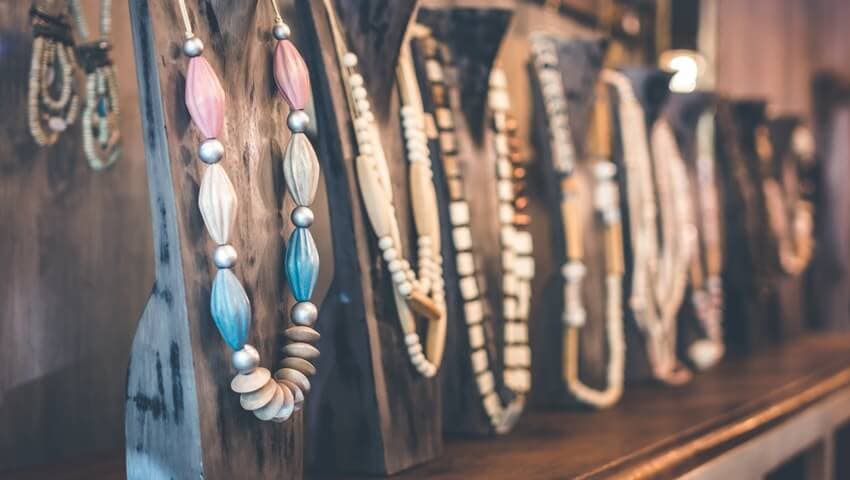How to Start a Jewelry Business in Canada

Starting a jewelry business is an excellent way to turn something you’re passionate about into something that’s profitable. Here’s how!
In 2020, the worldwide value of the global jewelry market was estimated to be $230 billion. This number is expected to increase to around $292 billion by 2025. With a passion for jewelry design, a product line, a business plan, and a marketing strategy, you can get a piece of that market.
But where do you start? How much does it cost to start a successful jewelry business? How do you start a small jewelry business from home? Let’s find out!
1. Determine your products
The first step to creating your small business is deciding what type of jewelry you would like to sell. Will you be selling fine jewelry or costume jewelry?
Fine jewelry is made with precious and semi-precious metals and gems, has a higher price point, and is typically made with excellent craftsmanship (instead of being mass produced). Costume jewelry, also known as fashion jewelry, is usually trendy, a lower price point, and can be mass produced.
Perhaps the biggest difference is that costume jewelry is made with inexpensive or less expensive metals and materials. These may include, but are not limited to, wire, beads, plated metal, plastic, and synthetic gems.
Deciding on what type of jewelry you would like to sell may depend on your target audience and potential customers. Figure out if you’d like to make jewelry for the everyday consumer. Or perhaps you wish to make jewelry for a niche market such as the luxury, wedding, and/or special occasion customer.
2. Define your jewelry brand
Once you have determined what type of jewelry you will be selling, it is time to define your brand. This is your voice, mission, and your brand story. It can be communicated to customers through your brand name, social media posts and/or a webpage, and tells customers how to feel about your products.
The next thing to consider is branding, and how your business will be represented visually. Your logo, business cards, packaging, and your website are all aspects of branding that you will want to consider as these are representative of your business and the quality of your products.
Creating consistency across these fronts is a small thing that you can do to ensure that customers are able to recognize your brand.
3. Register your business
Once you’ve created your business name, you’ll need to ensure that you register your business and have all your legal bases covered.
If you’re running your business out of your home, you may need to check with your landlord or your local clerk’s office about licensing and permit requirements.
You may choose to register your business as a sole proprietorship (although in some cases, you could be held personally responsible if your business runs into any legal issues) or as an LLC.
You may also want to register a trademark for your business name, logo, and/or designs.
4. Get insured
If you’re looking to start a successful jewelry business, then you’ll need insurance. Professional liability insurance is a necessity for small business owners, as it protects them from any unforeseen difficulties that can result in potentially crippling fees.
These are some types of insurance that you should look into:
Product Liability Insurance
This protects your business from any legal fallout that may occur if a product causes injury to a customer or a third party.
This policy protects your business from any accidents or injuries that may occur within your jewelry store.
However, if you hire employees then you may need to consider additional coverage.
5. Start production
Once you’ve registered your business, determined your products, defined your brand, and covered your company, you’re ready to jump into the jewelry industry and begin production.
Depending on your skill level, complexity of designs, materials, and price point, you could develop your products by hand, in a factory, at home, or outsource.
Here are the four main ways to make jewelry:
Handcrafted Production: Fine and one-of-a-kind jewelry
Handmade Production: Fashion and costume jewelry
Machine Production: Factory outsourced for mass creation
On-Demand Production: Print on demand, such as 3D printed or recreated in stainless steel, wood, plastic, gold, or silver
Your production choices will depend on your unique vision and business needs.
6. Set up your jewelry business studio or workshop
A studio or workshop may be next on your list whether you’ve decided to run your business out of your home or a separate work space.
If you choose to run your jewelry business out of your home, then you’ll need to ensure that you have ample space available to you.
Not only that, but you should also ensure that your work area is safe and that you have enough storage. This will ensure that your home business stays organized and that you are able to keep enough products in stock that are easily accessible when business is booming.
If you would prefer to have a small storefront for your jewelry store, then you may look into work spaces outside of your home. In that case, you should still take maneuverability, safety, and storage into consideration, but you’ll also want to find a space that is aesthetically pleasing and fits with your brand.
7. Take some professional photos of your product
Once you have your business set up and have accumulated some stock, you may feel ready to start selling.
Paying to have a photographer take some professional photos of your products will help immensely with jewelry marketing, building your brand, and appealing to customers. Although it may seem expensive, you’ll be thankful for these photos later!
8. Build your online store
Now that you’ve got stock and photos of your products, you’re ready to build an online store!
You may choose to post your items on sites such as Etsy, as these are incredibly user-friendly and great for getting your brand name out there to build up a base of customers. This might be a great option if you’re looking for low startup costs or are wanting to manage your online store yourself.
Alternatively, you may choose to build a website that is exclusive to your unique brand and small jewelry business. Depending on your level of comfort with coding, you may decide to do this yourself or to hire someone to build and maintain your online store for you.
9. Market your ecommerce jewelry brand
Now that you’re ready to start selling your products, it’s important to consider how you would like to market your ecommerce inventory. When marketing your small business, it’s essential to consider your brand and how you would like customers to connect with your products.
A great way to do this is to include an “About” section in your website, or to provide customers with the stories behind your inspiration and your designs.
Marketing can also be done online through social media platforms, such as Facebook or Instagram. These high traffic websites can be great for exposing potential customers to your products, especially if you opt to pay for your products to run on these sites as ads.
You may even choose to offer discount codes or promotions to those who follow your jewelry brand on social media.
However, not all marketing needs to be done online. You may also choose to do pop-up shops at local markets or fairs. This can be an excellent way to build a client base wherever you are located.
Regardless of what type of jewelry you sell and how you choose to market your business, jewelry stores in Canada can be incredibly profitable.
With the right insurance coverage, you and your business will be protected from any unexpected challenges or legal fallout that may arise.
Originally published May 20, 2022, updated October 29, 2024
Back to APOLLO MagazineLooking for tenant insurance?
Get no-nonsense coverage that's the best value for your money. Purchase policies from your computer or phone, receive your documents instantly, and save when you buy online.
4.7 rating
Looking for tenant insurance?
Get no-nonsense coverage that's the best value for your money. Purchase policies from your computer or phone, receive your documents instantly, and save when you buy online.
4.7 rating
Relevant articles
Getting insured is as easy as 1 - 2 - 3

Tell us (very little) about yourself
Just tell us your address, your name, email and phone number. And that's it. We'll give you a price in less than a minute.

Pay online easily and securely
You can choose to pay monthly or save money by paying for the entire year in one easy payment.

Get your documents in your inbox - instantly
As soon as you complete your purchase, you'll find your proof of insurance and policy documents waiting for you in your inbox.
Get covered today - it couldn’t be easier
We’ve provided more than 1,000,000 quotes to Canadians just like you. Give it a try!



